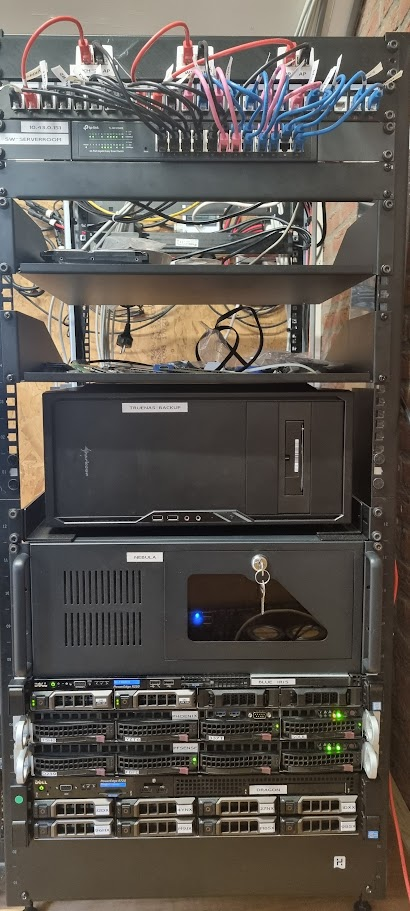Homelab!
 Slightly outdated, doesn't include 10G switch
Slightly outdated, doesn't include 10G switch
From top to bottom, my homelab contains the following hardware:
sw-serverroompoe: 16-port PoE switch (TP-Link TL-SG1016PE)- 24-port keystone patch panel (cheapest I could find)
sw-serverroom: 24-port switch (TP-Link TL-SG1024DE)sw-serverroom10g: 8-port 10 GbE switch (TP-Link TL-SX3008F)sdr: Raspberry Pi 5 with 2x RTL-SDR dongles attached- 4 GB RAM
- Broadcom BCM2712 SoC 4-core ARM CPU @ 2.4 GHz
- 64 GB SD-Card
truenas-backup: Old PC with some disks for weekly offline backups of important pools- 6 GB RAM (?)
- Old AMD A-series CPU (?)
- 5x2 TB HDDs (Raid-Z1 redundant)
nebula: Converted consumer server with 2 GPUs (running Proxmox)- 64 GB RAM
- Intel Core i7 7700k 8-core CPU @ 4.2 GHz
- 250 GB SSD (bootdisk), 2x1TB HDD (unused)
- 2x NVIDIA GTX 1070 GPU
- NVMe to 10G SFP+ adapter
blue-iris: Dell R330 server (running Blue Iris)- 16 GB RAM
- Intel Xeon E3-1230 v6 8-core CPU @ 3.5 GHz
- 250 GB SSD (bootdisk), 2x2TB SAS HDD (NVR storage)
- NVIDIA Tesla P4 GPU
phoenix: Supermicro 1U server (running Proxmox)- 64 GB RAM
- Intel Xeon E3-1230 v6 8-core CPU @ 3.5 GHz
- 500 GB SSD (bootdisk)
- Dual 10G SFP+
pfsense: Supermicro 1U server (running pfsense)- 16 GB RAM
- Intel Xeon E3-1270 v3 8-core CPU @ 3.5 GHz
- 2x120 GB SSD (mirrored bootdisk)
- Dual 10G SFP+
dragonnas: Dell R720 server with 8x4TB HDDs as a NAS (running TrueNAS)- 96 GB RAM
- Intel Xeon E5-2630L v2 12-core CPU @ 2.4 GHz
- 1 TB SSD (bootdisk)
- 8x4 TB SAS HDDs (bulk storage, Raid-Z2 redundant)
- 2x2 TB NVMe SSDs (VM storage, mirror redundant)
- Dual 10G SFP+ and dual 1G
Not locally, I have some additional VMs:
hetzner-docker-arm: An ARM VPS running Docker stacks through portainer that need a fast internet connection, a publicly accessible IP or both.redfire-vm: A VM running on the Homelab cluster of a friend of line, mainly running Uptime Kuma to monitor my public services.
Using the 2 TB NVMe SSD storage (soon to be 4 TB) on dragonnas, both hypervisors nabula and phoenix store
all VM disks on the network attached storage device.
In total, including running some PoE devices like a couple Wi-Fi APs and cameras, the total power consumption hovers around 400 watt, depending on what the cluster is doing.
Self-hosted Services
Some notable services that are running on the cluster are...
Blue Iris
Blue Iris is a really great NVR software, working with my ReoLink cameras. It really likes to have a GPU for hardware en- and decoding if you have more than just a couple cameras. It's running on a legit Windows Server 2016 license I found on a sticker on the R330 server!
Home Assistant
Of course, any home that has a room dedicated to servers needs smart devices. And what better way to control these devices than to control them all locally. I have a mix of Philips Hue lighting and switches, TP-Link Tapo energy monitoring plugs and some custom ESP stuff that I can control with my home assistant instance. Most of the communication also flows through MQTT, which allows me to create intuitive flows with Node-RED to, for example, control my ESP-relay-controlled doorbell chime when my Ring camera tells me someone presses the doorbell button.
I wrote many of these "mqtt-bridge" services myself. They are mostly semi-quickly written Python scripts, but they're written in such a way that it's easy to adapt to someone's custom environment and as stable as it can be. You can find these bridges on my GitHub here!
Pterodactyl
Who doesn't love some gaming with friends? I have Pterodactyl running to be able to quickly make Minecraft servers and the odd server for a random Steam game.
PiHole
Goes without saying of course! I have PiHole running in two different VMs, on two different hypervisors for redundancy. This has saved me a lot of times already when turning off a hypervisor, because I rely on my custom DNS to connect to them.
LanCache and APT cache
I run LanCache to cache Steam games and Windows updates, and AptCacherNg
to cache APT packages. I don't have a very fast WAN connection, so this helps a lot when updating. Also, seeing the multi-gigabit
speeds when apt upgrade-ing and (re)downloading a game is awesome!
Lots and LOTS of Docker stacks
The aforementioned services all run in VMs for various reasons, and I try to run most of my self-hosted services in Docker when possible. I'll add more information about them on here later, but for now, here's an incomplete list of my running stacks:
- immich
- grafana (+ prometheus/influxdb/telegraf)
- jellyfin & plex
- mosquitto
- various MQTT bridges, bridging APIs like the hue api to my MQTT broker
- nginx-proxy-manager for local HTTPS and a couple public services routed through Cloudflare tunnels
- node-red
- ollama
- docker registry
- uptime kuma
- some custom scripts for logging various things in Discord